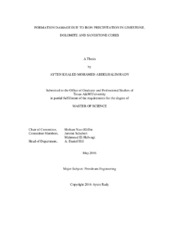| dc.description.abstract | Formation damage due to iron precipitation continues to be a major problem in the oil field. Research has established that as the pH of injected acid increases, iron (III) ions start to precipitate and block the pores in the formation, significantly reducing production. However, where exactly this iron precipitates and how iron precipitation changes with different lithologies has not yet been comprehensively studied.
Coreflood experiments were conducted on carobonate (calcite and dolomite) and sandstone cores to assess the effects of temperature and iron concentrations on the degree of damage caused by iron precipitation during an acid job. The temperature values tested were 200 and 300°F. Iron concentrations ranging from 5,000 to 10,000 ppm were used. The core effluent samples were analyzed by ICP (Inductively Coupled Plasma) to measure the concentrations of key cations.
Coreflood experiments, revealed that iron precipitates across the entire core. Iron precipitation was severely detrimental in sandstone cores compared to those composed of calcite and dolomite. While limestone cores showed the least formation damage from iron precipitation, coreflood tests indicated that as the iron concentration increases, the damage was more evident. On the other hand, increasing the temperature adversely affected sandstone and dolomite cores, but improved the final permeability of limestone cores.
In this study, the location of the iron precipitation is determined for three different lithologies. The effects of different parameters are studied to determine the best conditions that would lead to a decrease in iron precipitation and hence prevent formation damage. Iron control agents are not always needed, as previously thought. | en |


